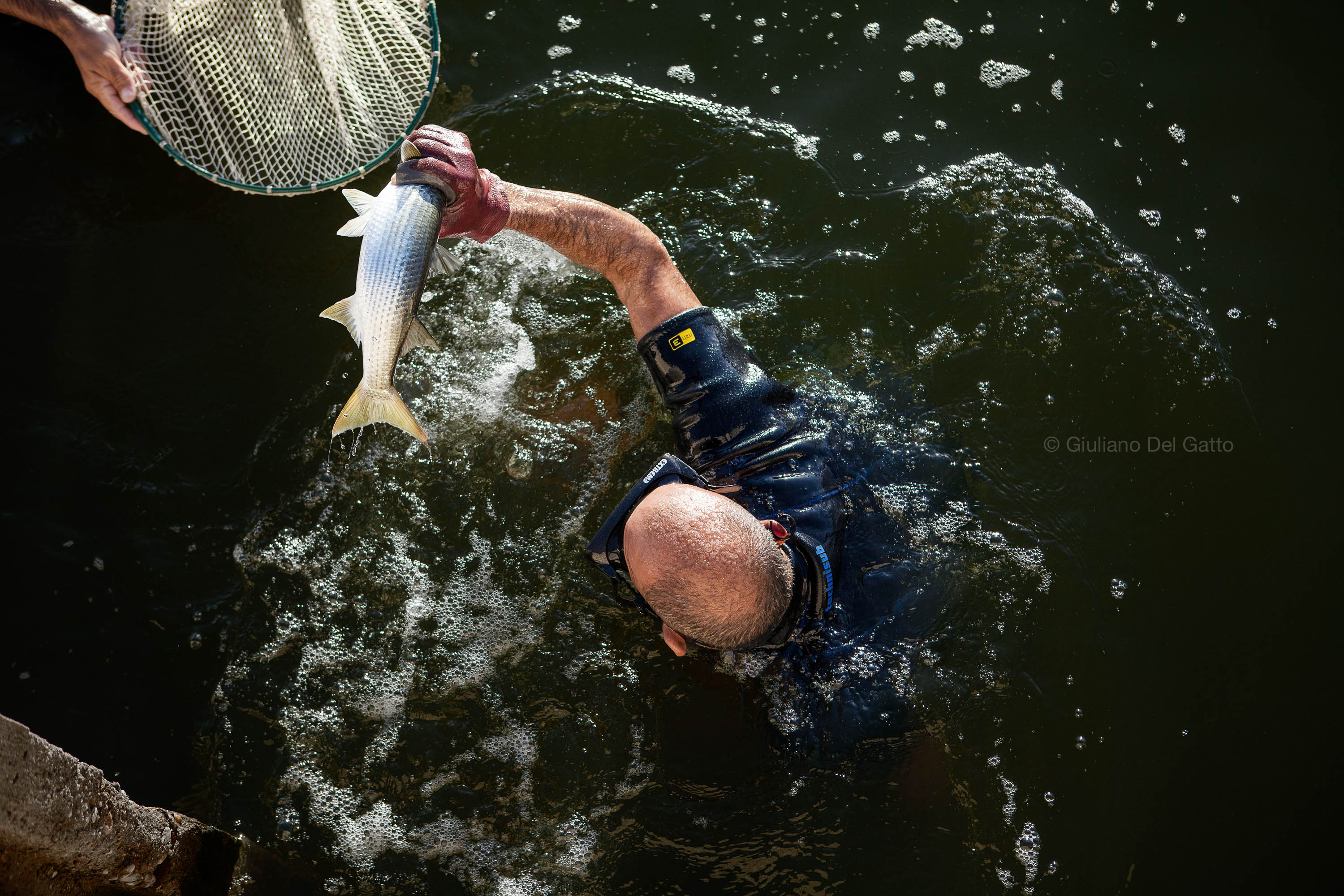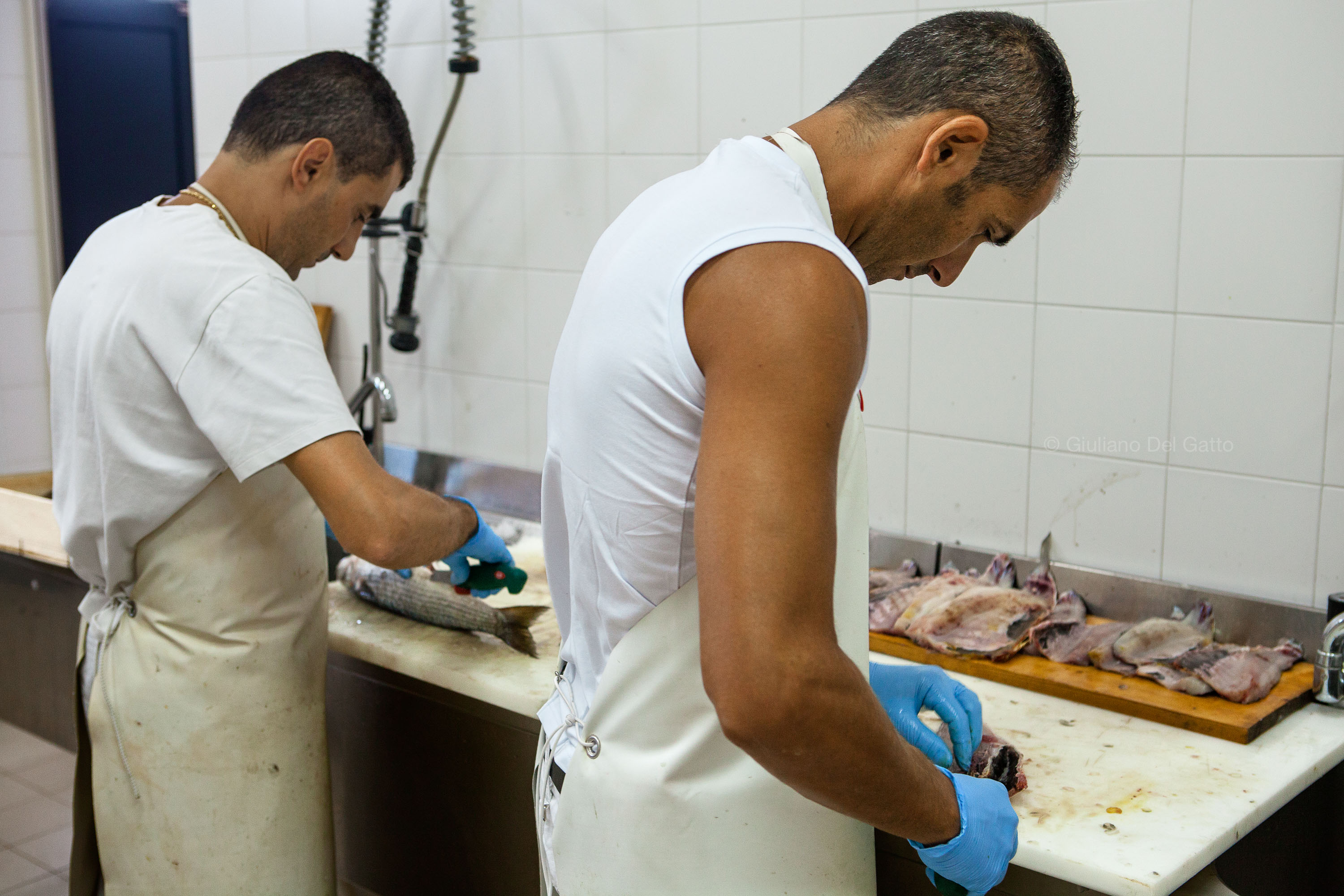
















Gold Of Cabras
Cabras (Oristano), Sardinia 2012ENG - Bottarga is a food made from salted and dried mullet's eggs, processed with traditional methods.
After three years of inactivity in August 2012, starts again the mullet fishing for the Bottarga production in the Mar'e Pontis fishpond, located in the seawater pond of Cabras, in the north west of Sardinia, province of Oristano. Fishing has been interrupted for a long period, the irrigation canals clogged, the dirty waters and the lack of oxygen in the water damaged the lives of fish, bred and fed in a natural way using only the resources of the pond.
The peculiarity of the mullet fishing is that it is done directly with hands to avoid damage to other fish species. Some nets are only used to bring fish near to the edges of the fishpond, making easier the capture. The mullets living in the fishpond can weight more than 2kg.
A warehouse, few miles away from the fishpond manages and collects the freshly caught fish. In the warehouse, the mullets, before the working process, are immediately preserved in the blast chiller, with the belly facing upwards not to damage the eggs. The extracted eggs are then dried, salted and sold as bottarga. The rest of the mullet will be filleted, the meat dried and sold separately. Of this process 70% of the fish is waste.
The service has been made possible thanks to the kind collaboration with Nuovo Consorzio Cooperative Pontis (www.consorziopontis.net).
After three years of inactivity in August 2012, starts again the mullet fishing for the Bottarga production in the Mar'e Pontis fishpond, located in the seawater pond of Cabras, in the north west of Sardinia, province of Oristano. Fishing has been interrupted for a long period, the irrigation canals clogged, the dirty waters and the lack of oxygen in the water damaged the lives of fish, bred and fed in a natural way using only the resources of the pond.
The peculiarity of the mullet fishing is that it is done directly with hands to avoid damage to other fish species. Some nets are only used to bring fish near to the edges of the fishpond, making easier the capture. The mullets living in the fishpond can weight more than 2kg.
A warehouse, few miles away from the fishpond manages and collects the freshly caught fish. In the warehouse, the mullets, before the working process, are immediately preserved in the blast chiller, with the belly facing upwards not to damage the eggs. The extracted eggs are then dried, salted and sold as bottarga. The rest of the mullet will be filleted, the meat dried and sold separately. Of this process 70% of the fish is waste.
The service has been made possible thanks to the kind collaboration with Nuovo Consorzio Cooperative Pontis (www.consorziopontis.net).
ITA - La Bottarga è un alimento a base di uova di muggine salate ed essiccate, lavorate con metodi tradizionali.Dopo tre anni di inattività, nell'agosto 2012, ricomincia la pesca dei cefali per la produzione della Bottarga nella peschiera di Mar'e Pontis, situata nello stagno di acqua marina di Cabras, nel nord ovest della Sardegna, in provincia di Oristano. La pesca è stata interrotta per un lungo periodo, i canali di irrigazione intasati, le acque sporche e la mancanza di ossigeno nell'acqua hanno danneggiato la vita dei pesci, allevati e nutriti in modo naturale utilizzando solo le risorse dello stagno.La particolarità della pesca del cefalo è che si fa direttamente con le mani per evitare danni alle altre specie di pesci. Alcune reti sono usate solo per avvicinare i pesci ai bordi della peschiera, facilitando la cattura. I cefali che vivono nella peschiera possono pesare più di 2 kg.Un magazzino, a poche miglia dalla peschiera, gestisce e raccoglie il pesce appena pescato. Nel magazzino, i cefali, prima della lavorazione, sono immediatamente conservati nell'abbattitore, con il ventre rivolto verso l'alto per non danneggiare le uova. Le uova estratte vengono poi essiccate, salate e vendute come bottarga. Il resto del cefalo viene sfilettato, la carne essiccata e venduta separatamente. Di questo processo il 70% del pesce è scarto.
Il servizio è stato reso possibile grazie alla gentile collaborazione con il Nuovo Consorzio Cooperative Pontis (www.consorziopontis.net).
Il servizio è stato reso possibile grazie alla gentile collaborazione con il Nuovo Consorzio Cooperative Pontis (www.consorziopontis.net).